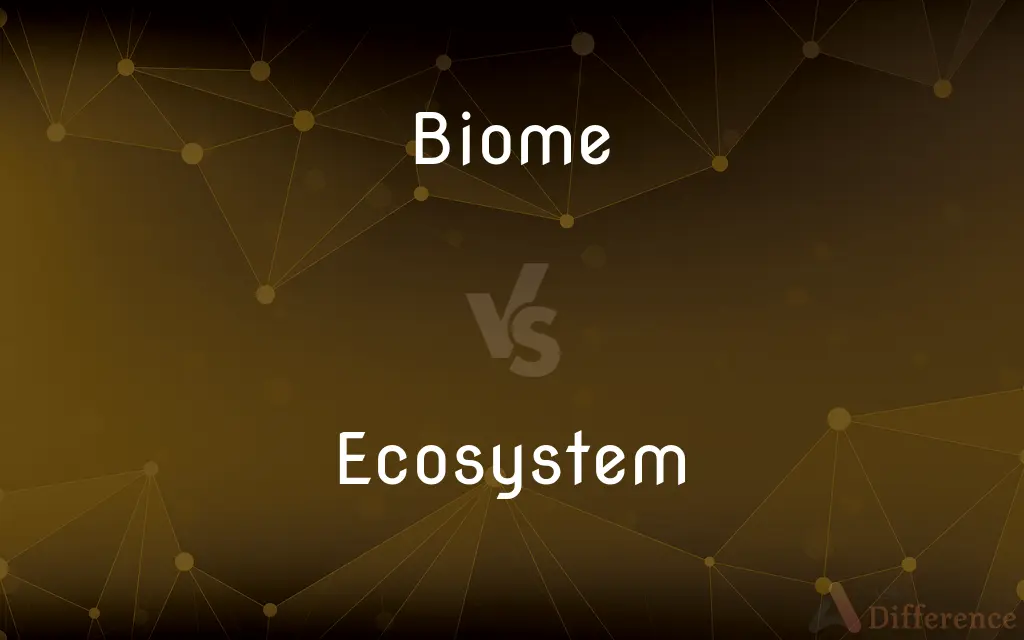Biome vs. Ecosystem — What's the Difference?
By Maham Liaqat & Fiza Rafique — Updated on April 18, 2024
Biomes are large geographical areas with specific climates and ecosystems, while ecosystems are smaller areas within biomes where living organisms interact with each other and their environment.

Difference Between Biome and Ecosystem
Table of Contents
ADVERTISEMENT
Key Differences
Biomes are categorized based on their climate and predominant vegetation, encompassing large geographical areas. On the other hand, ecosystems can vary in size from a small puddle to a vast desert, focusing more on the interactions within specific environments.
The concept of a biome includes broad categories like forests, deserts, and tundras, which are defined by their global locations, climate, and general vegetation types. Whereas ecosystems are characterized by both biotic (living) and abiotic (non-living) components specific to a smaller area, such as a coral reef or a forest floor.
Biomes provide a macroscopic view of the Earth’s surface, useful for studying global ecological patterns and climate change impacts. In contrast, ecosystems offer a microscopic view, ideal for examining specific interactions and ecological dynamics within various environments.
While biomes are primarily influenced by macro-climatic conditions like temperature and precipitation, ecosystems are shaped by more localized conditions, including soil type and water availability, which directly affect the living organisms found there.
Understanding biomes helps in environmental management at a broader scale, like addressing deforestation in rainforests. Conversely, ecosystem studies are crucial for conservation efforts, such as species recovery programs and habitat restoration.
ADVERTISEMENT
Comparison Chart
Scale
Large geographic areas
Smaller specific areas within a biome
Focus
Climate and vegetation types
Interactions among organisms and their environment
Examples
Forest, desert, tundra
Coral reef, forest floor
Importance in Studies
Global ecological patterns, climate change
Specific interactions, ecological dynamics
Influential Factors
Macro-climatic conditions (e.g., temperature)
Local conditions (e.g., soil type, water availability)
Compare with Definitions
Biome
A large ecological area on the earth's surface with flora and fauna adapting to their environment.
The Arctic tundra biome is characterized by extreme cold and long periods of daylight or darkness.
Ecosystem
A community of living organisms in conjunction with the nonliving components of their environment, interacting as a system.
A pond ecosystem includes fish, water plants, and microorganisms.
Biome
Defined by abiotic factors like climate and soil type.
Tropical rainforest biomes are distinguished by high rainfall and humidity.
Ecosystem
Can exist within any biome and vary greatly in size.
A micro-ecosystem can exist within a hollow log.
Biome
Influenced by global climate patterns.
Grassland biomes are found where there is enough rain to support grasses but not enough for large forests.
Ecosystem
Influenced by both biotic and abiotic factors.
An estuary ecosystem is affected by both the salt water of the sea and the fresh water of the river.
Biome
Can encompass multiple ecosystems.
The forest biome includes various ecosystems with different types of trees and wildlife.
Ecosystem
Can be as small as a drop of water or as large as a forest.
Even a small aquarium can be considered an aquatic ecosystem.
Biome
A division of the Earth's surface based on predominant vegetation and climate.
Desert biomes are typically arid and feature sparse vegetation.
Ecosystem
Maintains energy flows and material cycles.
Forest ecosystems recycle nutrients through the decay of fallen leaves.
Biome
A biome is a distinct biogeographical unit consisting of a biological community that has formed in response to a shared regional climate. Biomes may span more than one continent.
Ecosystem
An ecosystem (or ecological system) consists of all the organisms and the physical environment with which they interact. These biotic and abiotic components are linked together through nutrient cycles and energy flows.
Biome
A major regional or global biotic community, such as grassland or desert, characterized chiefly by its prevailing climate and vegetation.
Ecosystem
An ecological community together with its environment, functioning as a unit.
Biome
Any major regional biological community such as that of forest or desert.
Ecosystem
A system formed by an ecological community and its environment that functions as a unit.
Biome
All the genomes of such a community.
Ecosystem
The interconnectedness of organisms (plants, animals, microbes) with each other and their environment.
Biome
A specific type of complex ecological community characterized by specific environmental conditions and a distinctive group of plants and animals, maintained in a relatively stable equilibrium, such as a rain forest biome or prairie biome.
Ecosystem
(by extension) A network of interconnected people or organisations that resembles a natural ecosystem due to the complex interdependencies.
The company’s ecosystem mainly comprises its supply chain, customers, end consumers and competitors.
Biome
A particular region which is a biome{1}.
Ecosystem
A system formed by the interaction of a community of organisms with their physical environment
Biome
A major biotic community characterized by the dominant forms of plant life and the prevailing climate
Common Curiosities
What factors define a biome?
Climate and predominant vegetation types are primary factors that define a biome.
What is an ecosystem?
An ecosystem encompasses the interactions between the living organisms, such as plants and animals, and their nonliving environment within a specific area.
Can an ecosystem exist outside of a biome?
No, ecosystems are specific interactions within a biome and cannot exist independently of a biome.
Which is larger, a biome or an ecosystem?
A biome is typically larger as it encompasses many ecosystems.
What is a biome?
A biome is a large area distinguished by specific climatic conditions and particular types of plants and animals.
How are biomes and ecosystems related?
Biomes are composed of many ecosystems. An ecosystem is a finer classification within the broader context of a biome.
Are biomes dependent on ecosystems?
While biomes are not dependent on any single ecosystem, the health and characteristics of biomes are influenced by the combined characteristics and interactions of their constituent ecosystems.
What is the primary focus when studying ecosystems?
The focus is on specific organism interactions and local environmental factors.
What factors influence an ecosystem?
Both biotic (living) and abiotic (non-living) factors influence an ecosystem, including local weather conditions, soil type, and the organisms present.
How does climate change affect biomes and ecosystems?
Climate change can alter the conditions of biomes, leading to shifts in ecosystems as species adapt to new temperatures and precipitation levels.
What is the primary focus when studying biomes?
The primary focus is on broad climatic patterns and vegetation types.
Can ecosystems overlap?
Yes, ecosystems can overlap or be nested within each other, such as a pond ecosystem within a forest.
Why is it important to study both biomes and ecosystems?
Studying both gives a comprehensive understanding of ecological dynamics at both macro and micro levels, crucial for effective environmental management and conservation.
How do biomes affect global ecology?
Biomes affect global ecology by influencing atmospheric conditions, global heat distribution, and large-scale ecological interactions.
What role do ecosystems play in biodiversity?
Ecosystems support biodiversity by providing varied habitats and niches for different organisms.
Share Your Discovery

Previous Comparison
Cape vs. Island
Next Comparison
Compliance vs. ComplaisanceAuthor Spotlight
Written by
Maham LiaqatCo-written by
Fiza RafiqueFiza Rafique is a skilled content writer at AskDifference.com, where she meticulously refines and enhances written pieces. Drawing from her vast editorial expertise, Fiza ensures clarity, accuracy, and precision in every article. Passionate about language, she continually seeks to elevate the quality of content for readers worldwide.














































